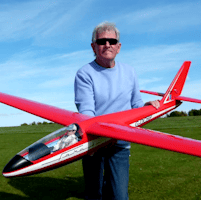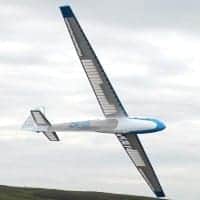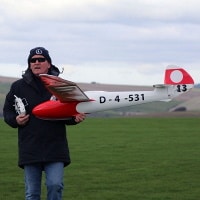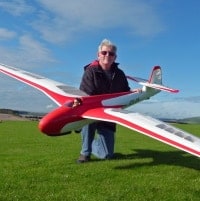Scale model of the SZD24 Fokka 4 Glider
Chris Williams Fokka 4 1/4.5 Short Kit
£245.00
Made to order
Made to order
Description
SZD-24 Fokka 4 from Chris Williams
Development
The SZD-24 Foka was designed for competition flying in the ‘Standard’ class as well as aerobatic flying. The design originated from a design competition within SZD which was won by the ”Delfin”, to become the SZD-24 Foka in production. The first flight, by SP-2069, took place in May 1960 at Bielsko but the results were not good with poorly performing airbrakes which could not limit the airspeed below VNE (Velocity Never Exceed). This posed a problem as OSTIV (Organisation Scientifique et Technique Internationale du Vol à Voile – International Scientific and Technical Organisation for Gliding) rules for the Standard class in gliding competitions stipulate that speed-limiting devices must limit maximum speed to VNE or below.
A second prototype was quickly built, fitted with much-improved air brakes as well as improved canopy locks and an additional access panel in the rear fuselage. Adam Zientek carried out the first flight of the second prototype on 24 May 1960, taking third place in the ‘Standard’ class at the 1960 World Gliding Championships at Köln in Germany, piloted by Adam Witek. The SZD-24 Foka prototype was admired for its performance, elegance, aerodynamically clean lines and comfortable semi-reclined flying position. The pre-production variant, called SZD-24A, introduced more refinements and the line was steadily improved up to the SZD-32 Foka 5 final production variant.
Description (SZD-24-4A )
The SZD-24 Foka series were Standard class gliders of predominantly wooden construction with fixed wheel and skid undercarriage.
Fuselage
The fuselage comprised a wooden structure with the cockpit in the extreme nose transitioning with very clean lines to the integral fin at the rear. The forward opening canopy was jettisonable in case of emergency and comprised plexiglass clear portions fitted to a ‘Duralumin’ frame. A 300 mm × 125 mm (11.8 in × 4.9 in) main wheel, with mechanically operated brakes connected to the airbrake lever, was fitted in a semi-recessed position augmented by flush fitting skids under the nose and tail. The construction methods of the fuselage evolved throughout the series culminating in large panels, formed in concrete moulds, of plywood and PVC foam sandwich giving a very smooth finish, high strength and reduced weight. The pilot sat semi-reclined in an adjustable back-rest seat with a headrest and non-adjustable rudder pedals.
The instrument panel sits on a column above and between the pilot’s legs, with basic instruments and supplementary instruments as required. A single tow hook is fitted to the left of the nose skid with a release control cable operated by a control knob at the base of the instrument panel. The forward sliding canopy comprised the entire top half of the forward fuselage which slid forward, on runners, controlled by a knob in a track on the left side of the cockpit rim. The canopy was constructed around a ‘Duralumin’ frame with a ‘Plexiglas’ transparent section and moulded opaque nose section.
Wings
The trapezoidal wings were built up with heavy gauge moulded plywood skins, supported by wooden ribs, using NACA 633-618 at the root changing smoothly to NACA 4415 at the tip. Large metal plate air brakes are fitted well aft of the main spar at approximately ¾ chord, in already-turbulent airflow. Roll control is provided by ailerons in the trailing edges of the outer wings. The SZD-24-2 Foka 2 was fitted with reduced area ailerons to reduce drag, but roll control was dramatically reduced.
Tail Unit
The sharply swept fin (used to increase control power and stability with a smaller fuselage, reducing weight), was integral with the fuselage and supported the plywood skinned tailplane at approx ⅓ fin span. The mass-balanced rudder and elevators were built up from wood/plywood and fabric covered.
As delivered the Foka’s were given a similar surface finish, with a broad stripe, tapering from the centre section to nose and tail, either side of the fuselage and a contrasting colour on the remainder of the fuselage. A large stylised Foka logo was added to the stripe under the cockpit. Wings were usually white with red wing tips.
Operational history
The Foka was the holder of seven world records and many Polish national records including:
300 km (190 mi) triangle World Record @ 62.29 km/h (38.71 mph) by Pelagia Majewska in 1960
300 km (190 mi) triangle World Record @ 72 km/h (45 mph) by Pelagia Majewska in 1963
300 km (190 mi) triangle World Record @ 82.5 km/h (51.3 mph) by Adela Dankowska in 1963 (later the same day)
World record Out and return Leszno-Olsztyn-Leszno (682 km (424 mi)) in 1964 by Jan Wróblewski
World record free distance of 744 km (462 mi) in 1964 by Henryk Lisiecki
First five places at the 1962 International Professional Gliding competition at Leszno in Poland.
Simultaneous completion of a 535 km (332 mi) triangle by 34 pilots flying ‘Foka’s at the Polish National Gliding Championships in 1964.
Other achievements by ‘Foka’ aircraft include:
Camille Labar first in the 1962 French National Gliding Championships.
Jaques Lacheny is first out of 47 in the European Cup Gliding championship.
The Foka 4 was also the only standard class glider ever to win the open-class World Gliding Championships, in 1965 at RAF South Cerney, Gloucestershire, piloted by Jan Wróblewski; Edward Makula in a Foka 4 came fourth. Foka 4’s piloted by F. Kępka and Jerzy Popiel came 3rd and 4th in the Standard class.
After several accidents attributed to structural failure, all Foka aircraft extant have now been limited to a maximum speed of 165 km/h (103 mph) in clear air and 140 km/h (87 mph) IFR/rough air.[1] Following a fatal accident due to the failure of the wing attachment mechanism in 2010 [2] and another fatal accident with a glider with a similar assembly mechanism, the British Gliding Association has issued a Safety Alert for owners of Foka IV gliders.[3]
Variants
Specifications (SZD-32a Foka5)
Data from The World’s Sailplanes:Die Segelflugzeuge der Welt:Les Planeurs du Monde Volume II<-h3>
General characteristics
Crew: One
Length: 7 m (23 ft 0 in)
Wingspan: 15 m (49 ft 3 in)
Height: 0.86 m (2 ft 10 in) at cockpit
Wing area: 12.16 m2 (130.9 sq ft)
Aspect ratio: 18.5
Airfoil: Root: NACA 633-618, Mid: NACA 633-618 (mod.), NACA 4415 (mod.)
Empty weight: 245 kg (540 lb)
Gross weight: 385 kg (849 lb)
Performance
Stall speed: 62 km/h (39 mph, 33 kn)
Never exceed speed: 260 km/h (160 mph, 140 kn)
Rough air speed max: 160 km/h (99 mph)
Aerotow speed: 140 km/h (87 mph)
Terminal velocity: with full airbrakes 255 km/h (158 mph)
g limits: +6 -3 at 146 km/h (91 mph)
Maximum glide ratio: 34
Rate of sink: 0.66 m/s (130 ft/min) at 75 km/h (47 mph)
Wing loading: 25.7 kg/m2 (5.3 lb/sq ft)





